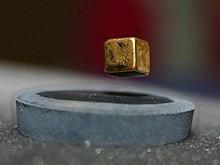Levitation (physics): Difference between revisions
Polyamorph (talk | contribs) Reverted to revision 458491489 by Polyamorph. (TW) |
Polyamorph (talk | contribs) Merge content from Electromagnetic levitation |
||
| Line 28: | Line 28: | ||
=== Electromagnetic === |
=== Electromagnetic === |
||
Electromagnetic levitation (EML), patented by Muck in 1923 <ref>O. Muck. German patent no. 42204 (Oct. 30, 1923)</ref>, enables the [[levitation]] of an object using [[electromagnetic radiation]]. A typical EML coil has reversed winding of upper and lower sections energized by an [[Radio frequency]] power supply.<ref>{{citation|author=Paul C. Nordine, J. K. Richard Weber, and Johan G. Abadie|journal=Pure and Applied Chemistry|title=Properties of high-temperature melts using levitation|year=2000|volume=72|pages=2127–2136|doi=10.1351/pac200072112127}}</ref> |
|||
{{main|Electromagnetic levitation}} |
|||
=== Electrostatic === |
=== Electrostatic === |
||
Revision as of 09:20, 2 November 2011

Levitation (from Latin levitas "lightness")[1] is the process by which an object is suspended by a physical force against gravity, in a stable position without solid physical contact. A number of different techniques have been developed to levitate matter, including the aerodynamic, magnetic, acoustic, electromagnetic, electrostatic, gas film, and optical levitation methods.
Physics
For levitation on Earth, first, a force is required directed vertically upwards and equal to the gravitational force, second, for any small displacement of the levitating object, a returning force should appear to stabilize it. The stable levitation can be naturally achieved by, for example, magnetic or aerodynamic forces.
Levitation techniques are useful tools in physics research. For example, levitation methods are useful for high-temperature melt property studies because they eliminate the problem of reaction with containers and allow deep undercooling of melts. The containerless conditions may be obtained by opposing gravity with a levitation force, or by allowing an entire experiment to freefall.[2]
Levitation methods
A number of different techniques have been developed and are commonly used to produce the stable levitation of matter. These methods are discussed below.
Magnetic

Although any electromagnetic force could be used to counteract gravity, magnetic levitation is the most common. Diamagnetic materials are commonly used for demonstration purposes. In this case the returning force appears from the interaction with the screening currents. For example, a superconducting sample, which can be considered either as a perfect diamagnet or an ideally hard superconductor, easily levitates an ambient external magnetic field. In very strong magnetic field, by means of diamagnetic levitation even small live animals have been levitated.
It is possible to levitate pyrolytic graphite by placing thin squares of it above four cube magnets with the north poles forming one diagonal and south poles forming the other diagonal. [3]

Magnetic levitation is in development for use for transportation systems. For example the Maglev transportation includes trains that are levitated by a very large number of magnets and, due to the lack of friction on guide rails, they are potentially faster, quieter and smoother than wheeled mass transit systems.
Electromagnetic
Electromagnetic levitation (EML), patented by Muck in 1923 [4], enables the levitation of an object using electromagnetic radiation. A typical EML coil has reversed winding of upper and lower sections energized by an Radio frequency power supply.[5]
Electrostatic
In electrostatic levitation an electric field is used to counteract gravitational force.
Aerodynamic
In aerodynamic levitation, the levitation is achieved by floating the object on a stream of gas, either produced by the object or acting on the object. For example, a ping pong ball can be levitated with the stream of air from a vacuum cleaner set on 'blow'.
With enough thrust very large objects can be levitated using this method. Helicopters and hovercraft, for example, use powerful downthrusts to achieve stable levitation.
Acoustic
Acoustic levitation uses sound waves to provide a levitating force.
Gas film
A common example of this is air hockey, where the puck is lifted by a thin layer of air.
Optical
Optical levitation is a technique in which a material is levitated against the downward force of gravity by an upward force stemming from photon momentum transfer.
Casimir Force
Scientists have discovered a way of levitating ultra small objects by manipulating the so-called Casimir force, which normally causes objects to stick together due to forces predicted by quantum field theory. This is, however, only possible for micro-objects.[6][7]
Buoyant levitation
Gases at high pressure can have a density exceeding that of some solids. Thus they can be used to levitate solid objects through buoyancy.[8] Noble gases are preferred for their non-reactivity. Xenon is the densest noble gas, at 5.894g/L. Xenon has been used to levitate polyethylene, at a pressure of 154atm.
Uses
Animal levitation

Scientists have levitated frogs, grasshoppers, and mice by means of powerful electromagnets utilizing superconductors, producing diamagnetic repulsion of body water. The mice acted confused at first, but adapted to the levitation after approximately four hours, suffering no immediate ill effects.[9][10]
Maglev trains
Magnetic levitation is used to suspend trains without touching the track. This permits very high speeds, and greatly reduces the maintenance requirements for tracks and vehicles, as little wear then occurs.
Further reading
- Schiller, Christoph (2007). Motion Mountain: The Free Physics Textbook. esp. the section on levitation in the chapter on electromagnetism.
- Charles P. Strehlow, M. C. Sullivan (2008). "A Classroom Demonstration of Levitation...". arXiv:0803.3090..
See also
References
- ^ Levitate, "to rise by virtue of lightness," from Latin levitas "lightness," patterned in English on gravitate: Online Etymology Dictionary
- ^ Paul C. Nordine, J. K. Richard Weber, and Johan G. Abadie (2000), "Properties of high-temperature melts using levitation", Pure and Applied Chemistry, 72: 2127–2136, doi:10.1351/pac200072112127
{{citation}}: CS1 maint: multiple names: authors list (link) - ^ Waldron, Robert D., "Diamagnetic Levitation Using Pyrolytic Graphite", Review of Scientific Instruments, 37: 29–35
- ^ O. Muck. German patent no. 42204 (Oct. 30, 1923)
- ^ Paul C. Nordine, J. K. Richard Weber, and Johan G. Abadie (2000), "Properties of high-temperature melts using levitation", Pure and Applied Chemistry, 72: 2127–2136, doi:10.1351/pac200072112127
{{citation}}: CS1 maint: multiple names: authors list (link) - ^ Scientists reveal secret of levitation, Yahoo! News
- ^ Levitation in Miniature, Null Hypothesis
- ^ http://www.mrs.org/s_mrs/sec_subscribe.asp?CID=12048&DID=275340&action=detail Materials Processing Through Levitation in High Gas Pressure
- ^ NASA Levitates a Mouse With Magnetic Fields, Popular Science, September 9, 2009
- ^ [1] Mice Levitated in Lab
External links
![]() The dictionary definition of levitation (physics) at Wiktionary
The dictionary definition of levitation (physics) at Wiktionary
